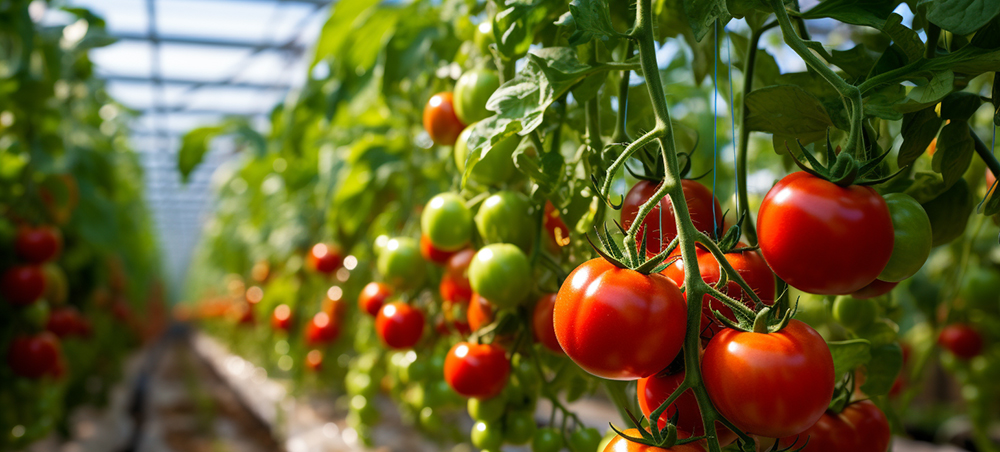How Green Light Can Boost Tomato Yield and Quality
Tomatoes are one of the most popular crops in the world, but growing them indoors can be challenging. You need to provide them with the right amount of light, water, nutrients, and temperature to ensure optimal growth and development. Among all, light is one of the most important environmental factors to get right. LED technology has allowed us to provide precise wavelengths, intensity, and photoperiods that tomatoes need for optimal growth. One color that is often overlooked but can have a tremendous impact is green light.
In this article, we will talk about what is green light and its benefits on tomatoes. If you want sweeter, juicier tomatoes with higher yields, tuning your grow lights to include a green light could make all the difference.
What is a green light?
Green light is a type of light that has a wavelength range of 500 to 600 nanometers. It is often considered as a less important or even a harmful light for plants. It is believed to be reflected or transmitted by most plant leaves and to interfere with the photosynthesis and photomorphogenesis of plants. However, recent studies have shown that green light can have positive and beneficial effects on tomato plants, especially when combined with other light colors such as red and blue.

Benefits of green light on tomato plants
Green light is not only beneficial for the growth and development of tomato plants but also for their health and resistance. Utilizing green light in horticulture lighting systems can significantly enhance the overall success of tomato cultivation. Let’s explore some of the key benefits of green light for tomato plants:
Enhanced photosynthesis
Green light has been found to boost photosynthetic efficiency in tomato plants. While red and blue light are essential for photosynthesis, green light complements this process by stimulating chlorophyll synthesis and increasing energy production. By optimizing the green light spectrum, growers can enhance photosynthetic rates, leading to healthier plants with increased biomass and improved growth.
Regulation of plant structure
Green light plays a vital role in shaping the structure and growth patterns of tomato plants. By exposing tomatoes to higher levels of green light, growers can influence photomorphogenesis, resulting in reduced stem elongation and more compact growth. The controlled architecture promotes stronger stems, prevents legginess, and optimizes space utilization within cultivation facilities.
Increase flower production
Green light has been observed to stimulate flower production in tomato plants. By providing the appropriate green light spectrum during critical growth stages, growers can promote the development of more flowers, leading to increased fruit sets and ultimately higher yields. This benefit is particularly valuable for commercial tomato growers aiming to maximize their productivity.
Fruit development and size
Green light influences the development of tomatoes, both in terms of color and size. It enhances the synthesis of pigments responsible for color development, resulting in visually appealing, vibrant fruits. Additionally, the green light has been linked to larger fruit sizes, offering growers the opportunity to cultivate tomatoes with enhanced market value and customer appeal.
Once tomatoes begin setting, green light improves fruit quantity and quality. It helps develop bigger, heavier tomato fruits with higher average weights. A study conducted by Wageningen University and Research (WUR) has revealed intriguing findings regarding tomato cultivation in greenhouse environments using LED lights. The experiment focused on comparing the effects of different light spectrums on tomato growth. Specifically, tomatoes were exposed to LED lights emitting solely blue and red light, as well as lights with varying proportions of green light mixed with blue and red (Weerheim et al., 2019). The outcomes of the research highlighted that the inclusion of 40% green light in the LED output spectrum led to a remarkable 6% increase in the yield of greenhouse tomatoes.

Improved flavor and nutritional content
Green light can positively impact the flavor and nutritional content of tomatoes. Studies have shown that green light exposure enhances sugar accumulation, resulting in sweeter-tasting fruits. Moreover, it has been associated with increased antioxidant levels, promoting healthier and more nutritious tomatoes.
Green light is ideal to use during the flowering and fruiting stages, as opposed to vegetative growth which favors more blue light. Start by adding about 5-40% green to your existing red/blue LED system. Slowly increase the intensity to find the optimal balance, which typically falls around a 1:1:1 ratio of red, blue, and green. Adjust this based on crop response.
In conclusion, incorporating green light into horticulture lighting systems offers numerous benefits for tomato plants. From enhanced photosynthesis and regulated plant architecture to increased flower production and improved fruit development, green light has the potential to significantly boost tomato yield and quality. By harnessing the power of green light, growers can optimize their cultivation practices, and cater to consumer demands for flavorful and visually appealing tomatoes.
Now, you know that a green light can boost the yield and quality of tomatoes. It is time to take action. Whether you need customized horticulture lighting or green light supplemental lighting, we have the right solution.

